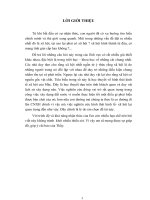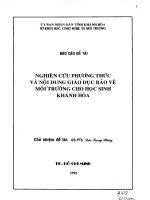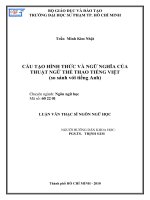Flyers Format and Content (Hình thức và Nội dung của bài Flyers)
Bạn đang xem bản rút gọn của tài liệu. Xem và tải ngay bản đầy đủ của tài liệu tại đây (70.07 KB, 3 trang )
Flyers Format and Content
Section Time Description # of items
Listening
about 25
minutes
Part 1
A big picture which shows people doing different things.
Above and below the picture, there are some names.
Candidates have to listen carefully to a conversation
between an adult and a child and draw a line from each
name to the correct person on the big picture.
5 questions
Part 2
A short conversation between two people. There is a form
or a page of a notebook with some missing words (gaps).
Candidates have to listen to the recording and write a
missing word or number in each gap.
5 questions
Part 3
Two sets of pictures. On the left, there are some pictures of
people and their names, or other named places or objects.
On the right, there is a set of pictures with letters but no
words. Candidates have to listen to a conversation between
two people and match each of the pictures on the right to
one of the named pictures on the left.
5 questions
Part 4
Five short conversations. There is a question and three
pictures for each conversation. Candidates have to decide
which picture shows the right answer to the question and
put a tick in the box under it.
5 questions
Part 5
A big picture. Candidates have to listen carefully to a
conversation between an adult and a child and color
different objects in the picture using the color they say in
the conversation. Candidates will also have to draw and
color a simple object somewhere on the picture.
5 questions
Reading &
Writing
40 minutes
Part 1
Fifteen words and ten definitions (sentences that describe
or explain ten of the fifteen words). Candidates have to
write the correct word next to each definition.
10 questions
Part 2
A big picture and seven sentences about the picture. Some
of the sentences describe the picture correctly and some do
not. If the sentence is true, candidates have to write 'yes'
after it. If the sentence is not true, candidates have to write
'no'.
7 questions
Part 3
A short conversations between two people. Everything that
the first speaker says is printed on the question paper, with
gaps for the second speaker's answers. For each gap,
5 questions
Section Time Description # of items
candidates have to choose the correct answer from a list
(A–H).
Part 4
A text with some missing words (gaps) in it. Each gap
represents a missing word (a noun, adjective or verb). Next
to the text there is a box with words in it. Candidates have
to choose the correct word from the box for each gap and
copy it. For the last question, candidates have to choose the
best title for the text from a choice of three possible titles.
6 questions
Part 5
A complete story, and seven sentences about the story.
Each sentence has a gap which candidates have to
complete using one, two, three or four words.
7 questions
Part 6
A text with some missing words (gaps). Next to the line
where each word is missing, there is a choice of three
possible answers. Candidates have to decide which answer
is correct and copy the word into the gap.
10 questions
Part 7
A text from a letter or diary with five gaps. Candidates
have to write the missing word in each gap, but there is no
list of words to choose from.
5 questions
Speaking 7-9 minutes
Part 1
The examiner will greet the candidate and ask their name.
The examiner then gives the candidate one picture and
keeps one picture which is similar but which has some
differences. The examiner reads some sentences about the
picture they have kept. The candidate must look at the
other picture and say how it is different.
4 parts
Part 2
The candidate and the examiner each have two similar
pictures (for example, pictures of two different
classrooms). The examiner has information about one
picture, and the candidate has information about the other
picture. First, the examiner asks the candidate questions
about one picture, then the candidate asks similar questions
about the other picture.
Part 3
The examiner shows five pictures which tell a story and
tells the candidate about the first picture. The candidate has
to continue the story and describe the other four pictures.
Part 4
The examiner asks the candidate some questions about
themselves (for example school, hobbies, birthday, family
or holidays).









